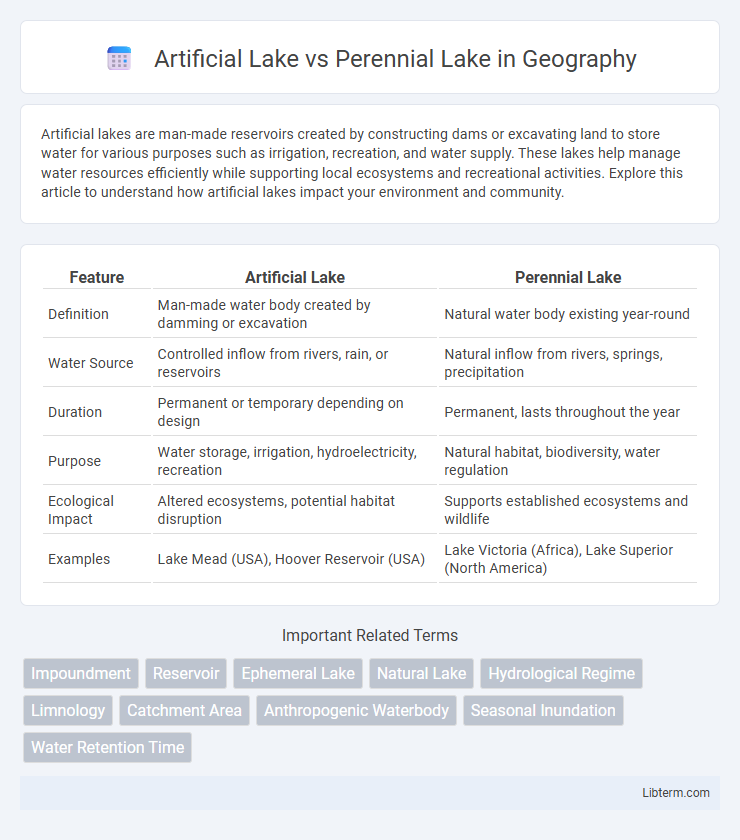Artificial lakes are man-made reservoirs created by constructing dams or excavating land to store water for various purposes such as irrigation, recreation, and water supply. These lakes help manage water resources efficiently while supporting local ecosystems and recreational activities. Explore this article to understand how artificial lakes impact your environment and community.
Table of Comparison
| Feature | Artificial Lake | Perennial Lake |
|---|---|---|
| Definition | Man-made water body created by damming or excavation | Natural water body existing year-round |
| Water Source | Controlled inflow from rivers, rain, or reservoirs | Natural inflow from rivers, springs, precipitation |
| Duration | Permanent or temporary depending on design | Permanent, lasts throughout the year |
| Purpose | Water storage, irrigation, hydroelectricity, recreation | Natural habitat, biodiversity, water regulation |
| Ecological Impact | Altered ecosystems, potential habitat disruption | Supports established ecosystems and wildlife |
| Examples | Lake Mead (USA), Hoover Reservoir (USA) | Lake Victoria (Africa), Lake Superior (North America) |
Introduction to Artificial and Perennial Lakes
Artificial lakes are human-made reservoirs created by damming rivers or excavating land, primarily for water storage, recreation, or hydroelectric power generation. Perennial lakes naturally maintain water throughout the year, supported by consistent inflows from precipitation, groundwater, or rivers, sustaining diverse ecosystems. Understanding the hydrological and ecological differences between artificial and perennial lakes is crucial for effective water resource management and environmental conservation.
Defining Artificial Lakes
Artificial lakes are man-made reservoirs created by constructing dams or excavating land to store water for purposes such as irrigation, hydroelectric power, or recreation. These lakes differ from perennial lakes, which naturally maintain water levels year-round due to consistent inflow and groundwater sources. The distinctive feature of artificial lakes is their engineered origin and controlled water management, contrasting with the natural hydrological cycles of perennial lakes.
Understanding Perennial Lakes
Perennial lakes maintain water levels throughout the year due to consistent inflow from groundwater, precipitation, and surface runoff, contrasting with artificial lakes that rely on human-made structures like dams. Understanding perennial lakes involves studying their natural hydrological cycles, ecological balance, and seasonal variations, which support diverse aquatic habitats. These lakes play a critical role in local water resources, biodiversity maintenance, and climate regulation.
Key Structural Differences
Artificial lakes are man-made reservoirs typically created by damming rivers or excavating land, characterized by engineered embankments and controlled water inflow and outflow systems. Perennial lakes are natural water bodies sustained year-round by balanced hydrological cycles, including continuous surface or groundwater inflows and stable climatic conditions. The primary structural difference lies in artificial lakes' reliance on human-made infrastructure for water retention, whereas perennial lakes depend on natural geological formations and environmental factors for their persistent water presence.
Ecological Impact and Biodiversity
Artificial lakes often disrupt natural habitats by altering water flow and temperature, leading to reduced native biodiversity compared to perennial lakes which maintain stable ecosystems year-round. Perennial lakes provide continuous habitats that support diverse aquatic and terrestrial species, enhancing ecological resilience and nutrient cycling. In contrast, artificial lakes may introduce invasive species and accumulate pollutants, resulting in imbalanced ecosystems and diminished ecological health.
Water Quality Considerations
Artificial lakes often face challenges in water quality due to limited natural inflow and reduced biofiltration, leading to potential nutrient accumulation and eutrophication. Perennial lakes typically maintain better water quality through continuous natural inflows and outflows, supporting stable aquatic ecosystems and natural contaminant dilution. Monitoring factors such as dissolved oxygen, nutrient levels, and pollutant concentrations is critical for managing the water quality in both lake types.
Usage and Human Benefits
Artificial lakes are primarily created for specific human uses such as irrigation, hydroelectric power generation, flood control, and recreational activities, offering controlled water management tailored to regional needs. Perennial lakes provide continuous natural water sources that support biodiversity, supply drinking water, and sustain agriculture year-round without the need for extensive human intervention. Both types contribute significantly to local economies and ecosystems, with artificial lakes enhancing utility through infrastructure and perennial lakes maintaining ecological stability.
Maintenance and Sustainability
Artificial lakes require regular maintenance including sediment removal, water quality monitoring, and structural repairs to sustain their intended functions and aesthetics. Perennial lakes maintain ecological balance naturally through ongoing water cycles, requiring minimal human intervention for sustainability. Sustainable management of artificial lakes involves engineered solutions for water replenishment and habitat support, contrasting with the self-sustaining ecosystems of perennial lakes.
Climate Adaptability
Artificial lakes offer enhanced climate adaptability by allowing controlled water levels and inflows, which can be managed to offset seasonal droughts or floods. Perennial lakes naturally maintain water throughout the year, supporting stable ecosystems but are more vulnerable to climate variability and extended dry periods. Climate resilience in artificial lakes is often improved through engineered infrastructure such as dams and reservoirs that regulate hydrological cycles.
Choosing the Right Lake Type for Different Needs
Artificial lakes offer controlled water levels and customizable designs, making them ideal for irrigation, recreational activities, or urban landscaping projects requiring specific features. Perennial lakes provide stable ecosystems with natural water replenishment, supporting biodiversity and long-term environmental balance suitable for wildlife habitats and conservation efforts. Selecting between these lake types depends on intended use, water source availability, maintenance capacity, and ecological impact priorities.
Artificial Lake Infographic

 libterm.com
libterm.com